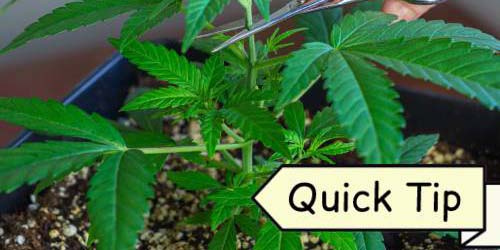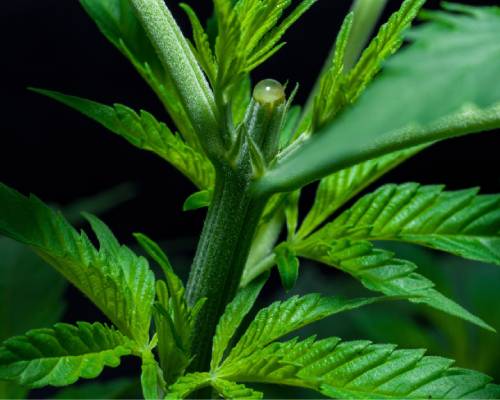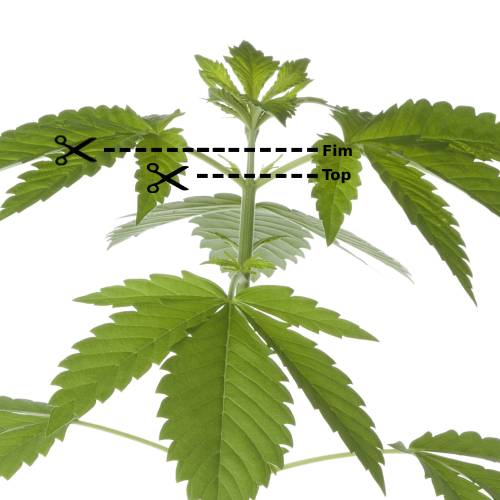
The most commonly used cultivation technique: topping a cannabis plant. An effective and simple way to train your cannabis plant for a higher yield. In this Quick Tip you can read in a few minutes how and when to top a cannabis plant. We also explain the difference with fimming cannabis plants.
Why Topping Cannabis Plants?
Topping is cutting off the top part of the cannabis plant's stem, but why would you do that?
- The main reason to top a cannabis plant is to create more growing points. When you prune back the main bud, two new buds will grow in its place. This multiplication of buds will increase the yield.
- By pruning back the main stem you limit the height of the cannabis plant. It will grow more in width than in height. Growers with limited space top their plants to keep out of trouble.
- A topped cannabis plant will have a thicker, sturdier trunk. That is why it is more resistant to accidents due to weather influences, for example.
- Topping your cannabis plant is a form of High Stress Training. Growers claim that when you top the plant at the right time, it gets stress that it can convert into extra energy, increasing yields.
When to Top a Cannabis Plant?
Topping puts a lot of stress on your cannabis plant. You can only top when the plant is big and strong enough to handle that stress. That is from the moment there are 3 to 4 nodes (branches) on your cannabis plant. Don't do it too late either, because after the 2nd to 3rd week of the flowering phase, your cannabis plant needs its energy to produce buds. The stress it causes after that time can actually reduce the yield.
So, when to top a cannabis plant? From the moment your cannabis plant has created 3 or 4 nodes until week 2 or 3 of the flowering phase.

A topped cannabis plant (trimmed trunk) with two new growth points that have arisen as a result.
How to Top a Cannabis Plant?
When topping a cannabis plant, it is important that you use clean, sterile scissors. Otherwise, your plant may get sick. Some people use their hands, but we don't recommend this for several reasons. Let it also be clear that you only cut the trunk and no side branches.
Open the scissors and place both sides on two side branches, so to speak, so that only the main trunk is between the two sides. Now cut the trunk as close as possible above the branches. If you do it right, the top of your cannabis plant will now not have one end in the form of a trunk, but two in the form of side branches.
Really try to cut the cannabis plant as short as possible above the two side branches, otherwise you can accidentally fimm the plant. Check out the photo below to see where the sweet spot is.

Difference Topping and Fimming Cannabis Plant
In addition to topping, you can also fimm a cannabis plant. In practice, the difference is in the place where you cut the trunk. Do you not do this directly above the side branches, but just a bit higher (see photo above)? Then you are fimming. The result? Not two new peaks are formed, but three or even four! That sounds good, but it also has disadvantages.
- An advantage of topping your cannabis plant is that you limit the height. When fimming, the height remains almost the same.
- Two new buds already provide a denser plant with more risks of diseases and fungi. With fimming, that risk only increases. Be prepared for that!
- Fimming a cannabis plant causes even more stress than topping. Autoflowers or photoperiod plants that are filmed late cannot cope with this, causing growth to stagnate.
So, topping or fimming a cannabis plant? You can do both, but be aware of the consequences. In any case, fimming provides more maintenance for the plant and a very important difference is that fimming is not suitable for autoflowers. Want to learn more growing techniques? Check out the blog.